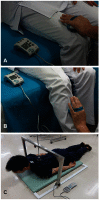Lumbar spinal stenosis associated with progression of locomotive syndrome and lower extremity muscle weakness
- PMID: 31496667
- PMCID: PMC6689136
- DOI: 10.2147/CIA.S201974
Lumbar spinal stenosis associated with progression of locomotive syndrome and lower extremity muscle weakness
Abstract
Purpose: The purpose of this study was to evaluate the association between the early stages of lumbar spinal stenosis (LSS) and the risk of locomotive syndrome, as well as its effect upon muscle strength of the back, upper extremities, and lower extremities.
Patients and methods: LSS was diagnosed with a self-administered, self-reported history questionnaire. Participants (n=113) who agreed to be tested by the diagnostic support tool for LSS underwent three risk tests for locomotive syndrome: a stand-up test, a two-step test, and a 25-question Geriatric Locomotive Function Scale (GLFS-25), as well as measurements of the strength of their grip, back extensor, hip flexor, and knee extensor muscles.
Results: Twenty-three participants were diagnosed with LSS by the questionnaire. Results of the stand-up test in the LSS group were significantly worse than those in the no-LSS group (P=0.003). The results of the two-step test and the total score on the GLFS-25 in the LSS group were significantly worse than those in the no-LSS group (P=0.002 and P<0.0001, respectively). The stages of locomotive syndrome assessed by the stand-up test, two-step test, and the GLFS-25 were significantly worse in the LSS group than in the no-LSS group (P=0.0004, P=0.0007, and P<0.0001, respectively). Hip flexor and knee extensor strength, but not grip and back extensor strength, in the LSS group were significantly lower than that in the no-LSS group.
Conclusions: LSS diagnosed using the self-reported support tool worsened the stage of locomotive syndrome in older people. Furthermore, participants with LSS had significant lower extremity weakness.
Keywords: back extensor strength; grip strength; locomotive syndrome; locomotive syndrome risk test; lower extremity muscle strength; lumbar spinal stenosis.
Conflict of interest statement
The authors report no conflicts of interest in regard to this work.
Figures

Similar articles
-
Lumbar spondylosis, lumbar spinal stenosis, knee pain, back muscle strength are associated with the locomotive syndrome: Rural population study in Japan.J Orthop Sci. 2016 May;21(3):366-72. doi: 10.1016/j.jos.2016.02.006. Epub 2016 Mar 22. J Orthop Sci. 2016. PMID: 27021251
-
Lumbar spinal canal stenosis leads to locomotive syndrome in elderly patients.J Orthop Sci. 2019 Jan;24(1):19-23. doi: 10.1016/j.jos.2018.08.004. Epub 2018 Sep 20. J Orthop Sci. 2019. PMID: 30243520
-
Lumbar spinal surgery improves locomotive syndrome in elderly patients with lumbar spinal canal stenosis: A multicenter prospective study.J Orthop Sci. 2020 Mar;25(2):213-218. doi: 10.1016/j.jos.2019.03.017. Epub 2019 Apr 11. J Orthop Sci. 2020. PMID: 30982707
-
Locomotive Syndrome and Lumbar Spine Disease: A Systematic Review.J Clin Med. 2022 Feb 27;11(5):1304. doi: 10.3390/jcm11051304. J Clin Med. 2022. PMID: 35268395 Free PMC article. Review.
-
[Locomotive syndrome and frailty. Lumbar canal stenosis as an underlying disorder in the locomotive syndrome].Clin Calcium. 2012 Apr;22(4):59-66. Clin Calcium. 2012. PMID: 22460512 Review. Japanese.
Cited by
-
Locomotive Syndrome Is Associated with Health-Related Quality of Life and Low Back Pain in the Elderly, Including Individuals More Than 80 Years Old.Prog Rehabil Med. 2020 Nov 26;5:20200029. doi: 10.2490/prm.20200029. eCollection 2020. Prog Rehabil Med. 2020. PMID: 33263091 Free PMC article.
-
Prevalence and physical characteristics of locomotive syndrome stages as classified by the new criteria 2020 in older Japanese people: results from the Nagahama study.BMC Geriatr. 2021 Sep 9;21(1):489. doi: 10.1186/s12877-021-02440-2. BMC Geriatr. 2021. PMID: 34503459 Free PMC article.
-
Lumbar Spinal Canal Stenosis from the Perspective of Locomotive Syndrome and Metabolic Syndrome: A Narrative Review.Spine Surg Relat Res. 2020 Aug 20;5(2):61-67. doi: 10.22603/ssrr.2020-0112. eCollection 2021. Spine Surg Relat Res. 2020. PMID: 33842711 Free PMC article. Review.
-
Association between musculoskeletal function deterioration and locomotive syndrome in the general elderly population: a Japanese cohort survey randomly sampled from a basic resident registry.BMC Musculoskelet Disord. 2020 Jul 3;21(1):431. doi: 10.1186/s12891-020-03469-x. BMC Musculoskelet Disord. 2020. PMID: 32620119 Free PMC article.
-
Impact of Habitual Exercise on Locomotive Function of Middle-aged and Elderly Volunteers: A Longitudinal Study.Prog Rehabil Med. 2021 Jan 30;6:20210006. doi: 10.2490/prm.20210006. eCollection 2021. Prog Rehabil Med. 2021. PMID: 33542962 Free PMC article.
References
-
- The state of the aging population In: White Paper on the Aging Society. Cabinet Office, Government of Japan; 2017. Available from: https://www8.cao.go.jp/kourei/whitepaper/w-2018/html/gaiyou/s11.html.
-
- Muranaga S. Evaluation of the muscular strength of the lower extremities using the standing movement and clinical application. J Showa Med Assoc. 2001;61(3):362–367.
-
- Muranaga S, Hirano K. Development of a convenient way to predict ability to walk, using a two-step test. J Showa Med Assoc. 2003;63(3):301–303.
MeSH terms
LinkOut - more resources
Full Text Sources
Medical

